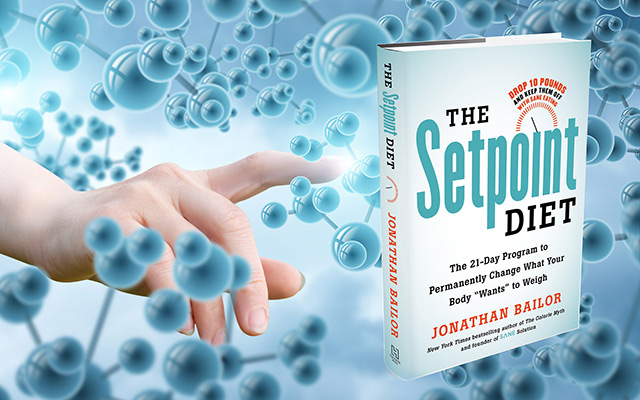If you’ve always had trouble losing weight and keeping it off, you may have a “hormonal clog,” which keeps your setpoint elevated.
In a nutshell, setpoint refers to the level of stored fat the body works to maintain by regulating your appetite and metabolism through your hormones, genes, and brain, regardless of the quantity of calories you take in or exercise off.
You see, there’s an invisible force inside you that is conspiring to cling to extra pounds, and it has nothing to do with calories, points, mail-order meals, cardiovascular exercise, or any of the conventional diet nonsense you’ve been fed — and that has failed you over and over for most of your life.
What’s truly holding you back — and what can permanently set you free — is your setpoint. Here’s the good news: It’s something you can control. And, when you control it, you stay naturally thin.
How Your Hormones Affect Your Setpoint Weight
You can’t hear it or see it, but there’s a whole lot of chitchat going on inside you all the time. Your gut, organs, muscle tissue, and fat tissue are constantly communicating with your nervous system and brain via chemical messengers called hormones. They “talk” about, for example, how much fuel they think you need to keep your weight stable at your setpoint. If they feel you’re at risk of your weight falling below your setpoint, they relay chemical messages that drive your appetite and cravings up and your daily calorie burn down.
When you eat high-quality calories, this conversation goes well. Higher-quality calories trigger fat-burning hormones. The right amount of hormones are used and the desired message is communicated: “Burn body fat.”
However, when you eat low-quality, processed calories, it’s like the phone lines break down. Your body doesn’t have a good idea of how much fuel you need. Hormones become “dysregulated,” and your body demands more food and hoards calories, because it does not know what is going on and errs on the side of not starving.
This “hormonal clog” elevates your setpoint and therefore triggers a 24/7/365 increase in appetite and cravings and a decrease in energy and calorie burn. More calories in and fewer calories out is what just about every cell in your body is telling you to do to survive. Even if you do grit your teeth and stick to your starvation diet and daily jog, this hormonal clog will cause your body to store more of the calories you eat as fat, while burning fewer off during exercise. In other words, you do what the “boot camp” instructor tells you: You “try harder,” but basic human biology causes your body to fight back by storing more and burning less.
Which Hormones Affect My Setpoint?
As you can see, hormones play a huge role in regulating your setpoint. Fortunately, you aren’t at their mercy. There’s a lot you can do to control your hormones and how they influence calories in, calories out, and setpoint. You just have to understand what they are and how they work. There are several main hormones that affect your setpoint and how well your body burns fat.
Leptin
Your fat cells produce a hormone called leptin, which signals your brain when it’s had enough food. As fat stores rise, more leptin is secreted, traveling to the brain with the message, “Your levels of body fat are on the rise so I’m going to make you feel full and fidgety so you unconsciously ‘eat less and exercise more.’” If fat levels fall, so do leptin levels, and your brain gets a strong hormonal signal to eat more and burn less. Leptin — not willpower — drives your motivation to eat and move.
Before you are victimized by internet ads for leptin supplements, please understand: Overweight people already have lots of leptin (remember, it’s secreted in proportion to the amount of fat on your body). The problem is, your setpoint gets elevated when you suffer from “leptin resistance,” in which the hormone is unable to get its message across. Therefore, increasing leptin levels to treat an elevated setpoint is as productive as adding water to a fish tank with no bottom.
You can ensure that leptin gets the job done by healing the metabolic breakdowns causing “leptin resistance.” Guess what makes the metabolic breakdowns worse? Conventional low-calorie, high-carb starvation diets.
Ghrelin
This hormone is all about appetite. Remember that when you cut calories and undereat, your body revolts. It starts defending a higher setpoint. As part of this defense, your brain signals an increase in ghrelin to get you to eat more. With traditional starvation diets, ghrelin increases. This is another big reason why traditional diets have failed you. They only make you hungrier and tell you to eat foods that caused the hormonal clog in the first place! Again, “you” are not doing anything “wrong.” Rather, ghrelin is out of balance, and you’ll be taking the right measures to get it back in check.
Insulin
We can’t talk about fat-burning hormones without talking about insulin, which is produced in the pancreas. For glucose to get into cells to be burned for fuel, it needs to open “doors” to the cells. These doors are the insulin receptors on the cells’ surfaces. Insulin’s function is to usher glucose into cells through those receptors.
When your body digests the sugars and starches you eat, it breaks them down into glucose, which gets absorbed into the bloodstream. Your insulin automatically spikes to shuttle the glucose into cells.
If you eat too much sugary, starchy, highly processed food, glucose levels stay elevated longer than they need to. More insulin is cranked out, and it has to work overtime. When insulin is elevated 24/7, insulin receptors on cells get so used to it that they stop recognizing it — a condition known as insulin resistance. Think of this situation like stuck doors; they (the cell receptors) just won’t open.
Insulin must still do its job of removing glucose from the bloodstream, however, so when most of the cells in the body won’t “open up” to it, the insulin has no choice but to take the glucose somewhere else: to your fat cells. Fat cells will always accept more energy for storage. This initiates the vicious cycle of high insulin, high blood-glucose levels, and, of course, more fat storage. If this cycle continues long enough, all the nonfat cells in your body scream, “We are starving!” This causes the body to respond by increasing its setpoint. In the wake of this increase comes obesity, insulin resistance, prediabetes, type 2 diabetes, and diabesity. Therefore, keeping insulin levels in check is vital not just for preventing diabetes, but also for maintaining a healthy, low setpoint and weight.
Testosterone
This hormone is commonly thought of as a male hormone, but both men and women need adequate testosterone levels to keep their setpoint low. Most adult women have about the same testosterone levels as a 10-year-old boy. That’s part of the reason it is harder for women to burn fat and build muscle than it is for men. Low levels of testosterone promote fat storage and inflammation. Excess testosterone in women, especially around menopause, is associated with insulin resistance and belly fat. You can see why having this hormone in the right balance is so important.
Eating lots of refined carbohydrates and soy foods will downshift testosterone and elevate setpoint, in both men and women. On the other hand, nutrient-dense proteins and whole-food fats as well as “eccentric” exercise optimizes testosterone, lowering your setpoint.
Estrogen
Like testosterone, estrogen is present in both men and women, though is higher in women. A few years prior to menopause, however, a woman’s estrogen levels begin to dip — which makes her body hold on to fat. The good news is that the same nutrition and lifestyle factors that optimize testosterone levels to favor a lower setpoint also shift estrogen in better balance for both women and men.
Stress Hormones
Secreted by the adrenal glands, stress hormones are involved in weight and hunger signals. One of the most influential on setpoint and weight is cortisol.
Among cortisol’s many functions is to trigger the release of insulin to get glucose into cells for the energy to deal with short-term stress. This is a part of your body’s survival response to stress. If a tiger starts chasing you (the typical type of short-term stress humans faced for the majority of our history), you need fuel fast. Then the crisis ends, the glucose is burned off, and a relaxation response gradually returns the body’s systems to normal.
This is a normal and lifesaving response from your body. The trouble is that your body responds to all stresses in the same way. If you are experiencing marital problems, financial worries, job stress, starvation, or worry, guilt, and shame over your weight, it’s all “a tiger is chasing you right now” from your body’s perspective.
This is not good because these chronic sources of stress cause your body to keep churning out cortisol as if you were always right on the verge of becoming a tiger snack. Because cortisol prompts the release of insulin, that hormone stays elevated, too, and based on what you just learned about insulin, this is all sorts of bad.
But wait, there’s more. The insulin resistance caused by this cortisol chaos triggers feedback to the brain indicating that cells aren’t getting glucose, which then leads to cravings for more glucose. Guess where you find the most glucose? Sugar and starches. Know what makes weight loss nearly impossible? Intense sugar and starch cravings. Also, now you know why when you get stressed, the comfort food craved always revolves around sugar and starch. Why? Your brain “thinks” it needs glucose to prevent a tiger from tearing you in half, so you end up tearing a bag of potato chips in half for your own survival.
In short, chronically elevated cortisol leads to increased insulin, insulin resistance, sugar and starch cravings, even more insulin, even more intense cravings, an elevated setpoint, weight gain, prediabetes, and then type 2 diabetes.
Thyroid Hormones
Restrictive, starvation-type dieting slows the function of your thyroid and your metabolism, thus elevating your setpoint. The thyroid produces the thyroid hormones: an inactive form called thyroxine (T4) and an active form called triiodothyronine (T3). The T4 is transported through the blood, and once it reaches each cell, it is converted to the active T3 form.
Both hormones regulate your metabolism, which, in turn, affects your setpoint along with your heart, brain, digestion, and other bodily systems. So if your thyroid isn’t rocking and rolling, it can affect almost every aspect of your health.
The most common problem is an underactive thyroid, or hypothyroidism, where levels of thyroid hormone are less than optimal. Among the main symptoms are fatigue, feeling cold, dry skin, weight gain (about 5 to 20 pounds), insulin resistance, depression, hair loss, and memory problems. More women than men suffer from hypothyroidism, largely due to fluctuating hormones during various life changes: onset of puberty, during and after pregnancy, at or just before menopause, and during postmenopause.
Other Setpoint Hormones
Cholecystokinin (CCK) is a hormone that is involved in satiety. Research has found that overeating can make receptors on cells less sensitive to CCK. This triggers another vicious cycle: The more low-quality food you eat, the less your body recognizes the signal to slow down.
Adiponectin is another hormone that affects setpoint. Secreted by fat cells, this helps regulate blood sugar and promotes fat-burning. In combination with leptin, it reverses insulin resistance. Levels stabilize when you lower your setpoint and replace starches and sweets with nonstarchy veggies and nutrient-dense proteins, and improve your fitness.
It’s Not About Calorie-Counting — or Willpower
I know this is a lot to take in. But understand that we all have a setpoint — and that’s what determines how thin or overweight we are long term. Not calorie-counting or traditional forms of exercising. When you increase the quality of your eating, exercise, and habits, you lower your setpoint — and get your body to burn fat rather than store it.
That’s what The Setpoint Diet is all about. It removes the willpower, shame, and guilt from the weight and diabetes equation. It ends the frustration and the yo-yo dieting. It stops the painful and expensive health consequences of diabesity, and does it with a proven system that will set the naturally thin person inside you free once and for all.
Adapted from the book THE SETPOINT DIET: The 21-Day Program to Permanently Change What Your Body “Wants” to Weigh by Jonathan Bailor. Copyright (c) Jonathan Bailor by Hachette Books. Reprinted with permission of Hachette Book Group, New York, NY. All rights reserved.




This Post Has 0 Comments